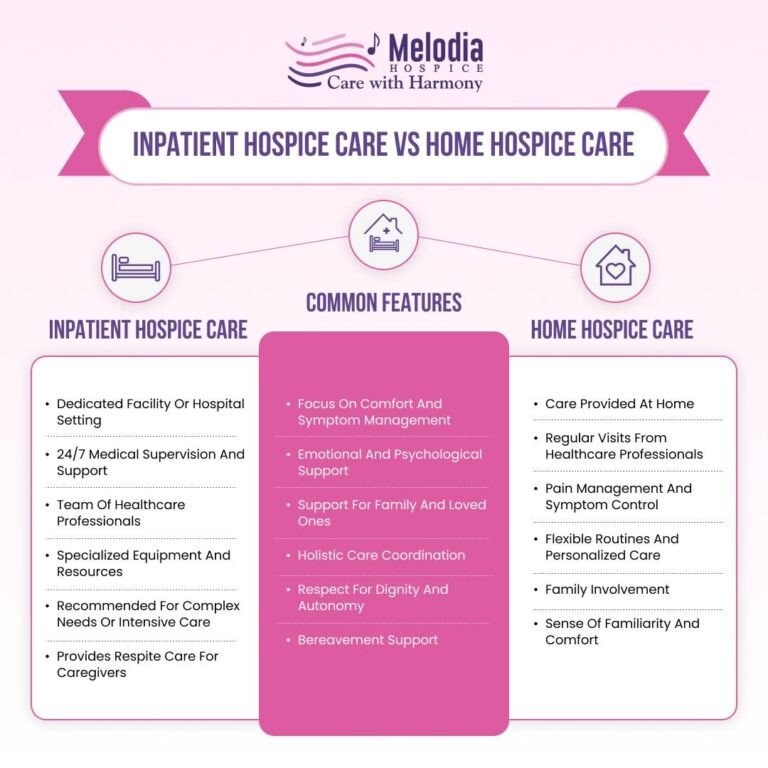Inpatient Hospice vs. Home Hospice Care
When dealing with a terminally ill patient, it is always difficult to decide what type of care is mandatory for your patient and in which setting. A family always wants a comfortable and relaxed environment and the best treatment for their terminally ill loved ones. Hence, they sometimes do not understand the needs of their loved ones and may opt for the wrong option. It is the duty of individuals to thoroughly research all possible medical options and then decide on the best medical treatment based on their findings.
One should know the basic difference between inpatient hospice care and home hospice care.
Inpatient hospice care and home hospice care are two different options for providing end-of-life care to individuals with life-limiting illnesses. While the primary goal of both types of care is to ensure comfort and support for patients.
Most terminally ill persons choose home care, continuing their daily routines. Hospice treats patients at home. Melodia Care Hospice provides more intensive treatment for complicated patients.
Choosing care for a terminal disease can be difficult. You can compare inpatient hospice care and home hospice care to make the most outstanding selection for your loved one’s future health. We’ll discuss each hospice care type’s pros and cons in this article so you can decide.

What's Hospice Care?

Hospice care is for patients with a six-month life expectancy or less. Hospitals and home care provide this service. It comforts rather than cures. Hospice care prioritizes quality over quantity.
Home Hospice

Your hospice team visits you, letting you be in place at home. An assisted living institution, nursing home, or residential program can provide home hospice care. Home hospice patients need a primary caregiver, usually a close friend or family member, who receives hospice instruction. Your home hospice service will also form a team of nurses, doctors, and specialists to provide virtual or in-home care.
Inpatient Hospice Care

Inpatient hospice care is frequently needed when a patient has no primary caregiver or needs more complex or consistent care than a home caregiver can offer. Hospice patients may use inpatient care when their primary caregiver is unavailable. Long-term care and hospital hospice units provide inpatient hospice care. Inpatient hospice care often aims to bring patients home for care.
Inpatient vs. Home Hospice
Inpatient hospice is administered in a medical facility. You can take care of other family duties while your loved one is there. Inpatient hospices offer counseling, nutritional counseling, pain treatment, and other services. You stay with your loved one at home during hospice care.
Pain management, therapy, and other therapies will help your loved one. Like inpatient hospice care, licensed medical professionals provide home hospice care. Inpatient or home hospice depends on your needs.
Long Term Hospice

Comfort matters. Long-term hospice care aims to keep you comfortable at home with your family. A doctor chooses whether you require outpatient hospice service or not.
Long-term hospice care includes visits from nurses, aides, and social workers to relieve pain and other symptoms. They’ll also check on your mental and emotional health, which is just as vital for terminal comfort.
Physical, occupational, and speech therapy may help you manage your symptoms. If hospice care worsens your mental health, you’ll receive psychological counseling to stay comfortable. Hospice patients can get emergency care beyond treating their medical problems, such as discharged patients with nowhere to go.
Hospital Based Hospice

Outpatient or inpatient hospice care? These guidelines will help you decide. When a family member has only days to live, he/she wants to spend every moment with their loved ones. Hospitals don’t usually accommodate long-term stays.
Outpatient hospice treatment may be beneficial for hospitalized palliative care patients. Inpatient hospice care may be helpful if you or your loved one is ready to return home. Be open-minded so you may focus on your loved ones in their final days.
The decision is difficult but affects you, your loved one, and your family. Consider your priorities before making a choice.
Hospice Is a Care Philosophy
Hospice is often viewed as a place. Hospice exists nowhere. Hospice care emphasizes comfort and quality of life in months, weeks, and days.
Melodia Care relieves pain and emotional and spiritual issues. Melodia Care enriches patients’ and families’ time.
Wherever You Live
Hospice care is available in private homes, assisted living facilities, and nursing homes. A physician, nurse, hospice assistant, chaplain, social worker, and volunteer provide clinical hospice services to patients wherever they live.
The team provides home pain management, symptom control, and personal care. The group educates caregivers and offers emotional and spiritual support to patients and their families.
Hospice care supplements assisted living and nursing home care. After a patient’s death, the facility’s personnel receive grieving services and is treated as an extension of the family.
Addressing Conditions That Are Worsening
Melodia Care helps patients stay home if their symptoms—pain, nausea, or confusion—worsen or become difficult to manage. If symptoms worsen, Medicare-certified hospices must provide scheduled shifts of continuous bedside care, avoiding hospitalization.
Inpatient Units

Hospice patients are usually treated at home, but sometimes they must be admitted to a hospital. That might be a Melodia Care inpatient unit or a contracted hospice bed in a local hospital. Inpatient hospice care treats symptoms so patients can return to homecare immediately.
Many hospice patients never need to be hospitalized and stay at home.
When Will My Loved One Need Hospice?

A loved one enters hospice when their doctor says they have six months or less to live. The family doesn’t need the doctor to recommend hospice. It’s best to keep communication open, advocate, and research all healthcare alternatives.
Hospice Components
Hospice care manages pain, symptoms, and emotional support for terminally ill patients and their families.
Hospice chaplains assist the patient and family in preparing emotionally. Hospice care includes bereavement support up to a year after a loved one dies.
Private hospice nurses and health aides provide compassionate care and prepare families for the dying process. Hospice social workers help families through this tough time.
At-Home Hospice Care: What Does It Mean?

Hospice at home involves in-home care. Nurses, aides, and social workers provide 24/7 care. The family can also be assured that we are always there to help them with daily activities.
Hospice care requires emotional support, so being near loved ones can be reassuring.
Hospice at home allows the patient’s family to make end-of-life decisions. They can choose how to spend their last days with family.
How Does a Home Hospice Differ From a Facility?
Off-site hospice treatment lets patients stay at home while doctors visit. In contrast, “inpatient” hospice programs require patients to see a facility for treatments and medications.
Most hospice care is given in the patient’s home. Hospice homecare is 56.5% private home facility and 42.5% nursing facility.
Melodia Hospice Care coordinates in-home hospice care. Hospice nurses and health aides will provide the best care to make patients comfortable. Melodia hospice nurses will coordinate all aspects of care, including social worker engagement, spiritual care, and bereavement support. Melodia Private Nursing Care can also arrange high-quality care for your loved one and family during this challenging time. Call 1-888-635-6347 today.

